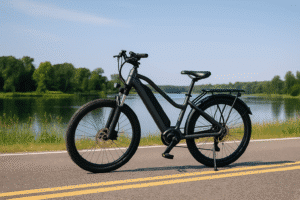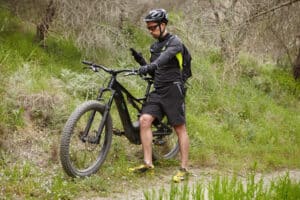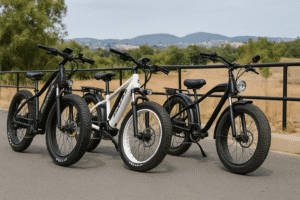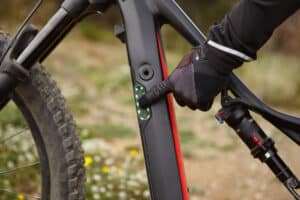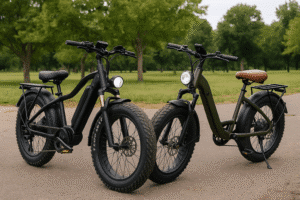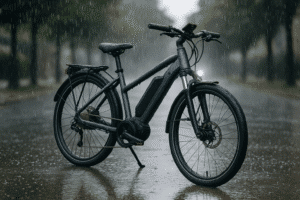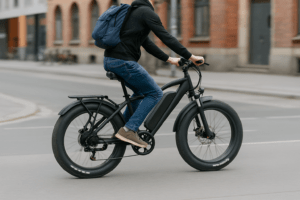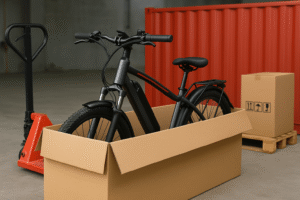E-bikes have come a long way in how they sense your effort. The technology that makes them feel smooth and intuitive is the torque sensor, one of the key parts of the pedal assist system.
It’s what separates premium e-bikes from the cheaper ones that can feel jerky or delayed. Knowing how it works can help you choose the right setup for your riding style.
Key Summary:
- A torque sensor measures how hard you pedal and adjusts motor power instantly.
- It offers a smoother, more natural feel than basic cadence sensors.
- Ideal for hilly areas, commuting, and riders who want better control.
- Found mostly in mid-range and premium e-bikes.
What is a Torque Sensor on an E-Bike?
A torque sensor is a part of an electric bike that measures how much pressure you’re putting on the pedals, then tells the motor how much help to give you.
Think of it like this: when you push harder on the pedals, the bike gives you more power. If you’re just cruising lightly, it eases off.
This creates a ride that feels more like a regular bike, just with a helping hand. It doesn’t jolt forward or lag behind, it simply responds to how you’re riding, in real time.
This sensor is usually tucked into the bottom bracket (where the pedals attach) or in the rear dropout. It’s constantly checking your pedal force and feeding that information to the motor, so the assistance feels smooth and responsive.
It’s especially helpful when you’re climbing hills or riding through stop-and-go traffic.
How Does a Torque Sensor Work?
The torque sensor works by measuring how much force you’re putting into the pedals and turning that into a signal the motor can understand.
Here’s what’s happening behind the scenes:
- It senses your pedal pressure, usually using strain gauges or magnets.
- That pressure gets translated into a tiny electrical signal.
- The signal tells the motor how much power to give you, based on how hard you’re pedaling.
- All of this happens in milliseconds, so it feels instant.
Some sensors can take up to 1,000 readings every second, which is why the power delivery feels so smooth and natural.
Benefits of Torque Sensors
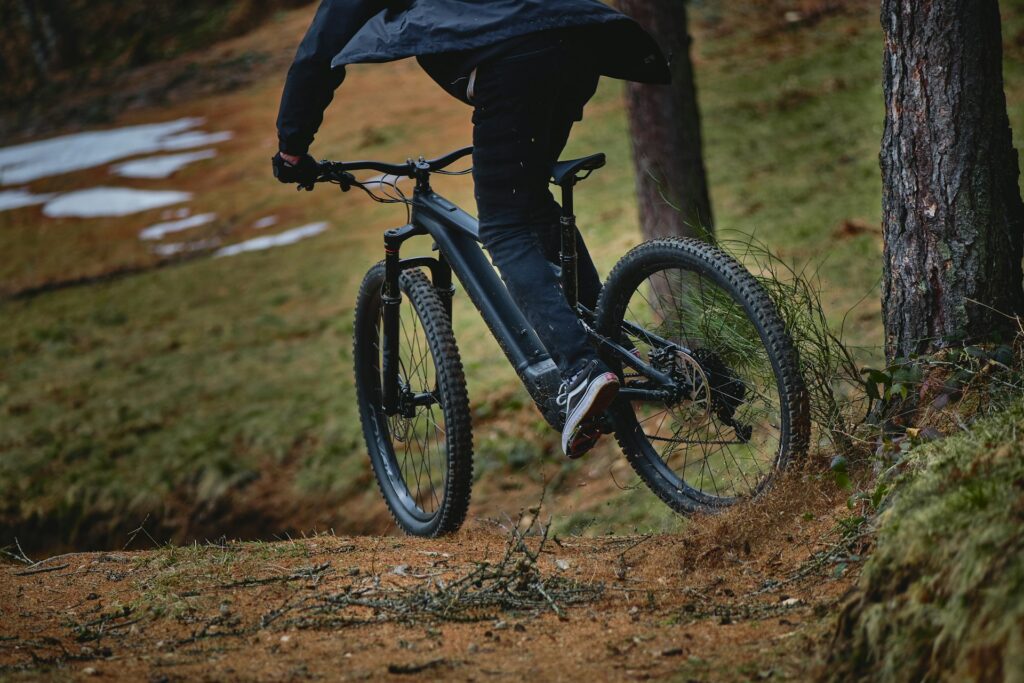
Torque sensors make your e-bike ride feel smarter and smoother. They respond to your pedaling in real time, so the motor gives you just the right amount of help.
- Natural ride feel – Instead of feeling like the motor is dragging you along, the bike responds to your effort. It feels more like riding a regular bike—just easier.
- Smoother power delivery – No lurching or sudden surges. The motor gently increases or decreases power as you pedal harder or softer.
- Better battery use – Since the motor only works as hard as you do, it doesn’t drain the battery as quickly. That means longer rides between charges.
- Improved handling on hills – The sensor gives extra power when you need it most, like climbing hills or starting from a stop.
- More control in traffic – You get steady, predictable power—important when riding through stop-and-go areas.
Read more: E-bike battery fully charged but not working
Types of Torque Sensors on an E-Bike
Not all torque sensors are placed in the same spot. Their position affects how they work and how easy (or tricky) they are to maintain.
Bottom Bracket Torque Sensors
This is the most common type. It’s placed between the cranks, right where your pedals attach.
These sensors use strain gauges or magnetic sensors to detect pressure from your pedaling. Because they’re positioned directly in the drivetrain, they can read force very accurately. The response time is fast, and the power delivery feels super smooth.
The downside? They’re not the easiest to access. If something goes wrong, you may need to remove the crank or chainring, and it’s best handled by a bike shop unless you know your way around bike tools.
Rear Dropout Torque Sensors
These are built into the rear dropout area, where the wheel connects to the frame.
They usually measure force through the chain or axle. While they might not respond quite as quickly as bottom bracket sensors, they’re easier to service. For casual riders, the difference is small, and the smoother ride is still there.
This setup also keeps the bottom bracket area simpler, which can make some repairs quicker and cheaper.
Read more: How to measure rear dropout fork on e-bike
Torque Sensor vs Cadence Sensor
A torque sensor measures how hard you’re pedaling, while a cadence sensor only checks if you’re pedaling.
The torque sensor gives motor power based on your effort. Push harder, get more help. Ease off, get less.
A cadence sensor just detects if the pedals are turning, regardless of how much effort you’re putting in. It works more like an on/off switch, and the power level depends only on the assist mode you’ve selected.
Cadence sensors are common in budget e-bikes. They’re simpler and easier to ride with if you want motor power without pedaling too hard. But torque sensors make the ride feel more in sync with your movements, which a lot of people prefer.
| Feature | Torque Sensor | Cadence Sensor |
|---|---|---|
| How it works | Measures pedal pressure and adjusts power instantly | Detects if pedals are turning and provides set power |
| Ride feel | Smooth, natural, responsive | Can feel jerky or delayed |
| Battery use | More efficient, adjusts output | Less efficient, uses fixed power |
| Price | Higher-end feature | Common in budget bikes |
| Best for | Commuters, hills, experienced riders | Casual riders, flat terrain |
Pros of Torque Sensor
Torque sensors give a ride that feels more like a regular bike—just easier.
- Smoother, more natural feel
- Power adjusts automatically to your pedaling
- Better control when climbing hills or riding through traffic
- Uses battery more efficiently
- Gives you more of a workout, if that’s what you’re after
Cons of Torque Sensor
That natural ride comes at a cost—literally and physically.
- Usually more expensive bikes
- Requires more pedal effort to maintain high speeds
- Can be trickier to fix or replace
Pros of Cadence Sensor
Cadence sensors are simpler and easier for beginners or casual riders.
- Less expensive overall
- Requires less effort, motor kicks in even with light pedaling
- Easier to maintain and repair
- Better for riders with injuries or limited strength
Cons of Cadence Sensor
But with simplicity comes a few trade-offs.
- Power delivery can feel jerky or delayed
- Less control when starting from a stop or going uphill
- Drains the battery faster
- Doesn’t respond to how hard you’re pedaling, just that you are pedaling
Signs Your Torque Sensor Might Need Maintenance
Torque sensors usually just work quietly in the background. But if something feels off, it might be worth a closer look.
- Motor lags when you start pedaling: If there’s a delay before the motor kicks in, the sensor might not be reading your pedal force properly.
- Sudden power cuts while riding: If the motor stops even though you’re still pedaling, the sensor could be misfiring or disconnected.
- Inconsistent or jerky power: A worn-out sensor can confuse the system, sending too much or too little help at the wrong times.
- Loud or strained motor sounds: If the motor sounds louder than usual during assist, it could be overcompensating for a faulty signal.
- Warning lights or error codes on display: Some e-bikes will flag sensor issues on the screen or through blinking lights.
Do You Really Need a Torque Sensor?
If you want an e-bike that feels more natural and easier to control, then yes—a torque sensor can make a big difference.
Torque sensors are great for riders who want their e-bike to respond to how hard they’re pedaling. Whether you’re riding through traffic, climbing hills, or just want something that feels more connected to your legs, this type of sensor delivers. It’s like having a bike that understands what you’re trying to do.
That said, they’re not for everyone. If you prefer a more relaxed ride where the motor does most of the work without needing much pedal pressure, a cadence sensor might suit you better.
Some riders with knee pain or mobility issues also find cadence-based systems easier to handle.
If you’re somewhere in between, look for bikes that have both sensors. These give you the best of both worlds—easy starts with smooth, responsive control once you’re moving.
Read more: Tips for choosing electric bikes for every type of rider
Final Words
A torque sensor on an e-bike measures how hard you’re pedaling and adjusts the motor support to match your effort. It makes riding feel smoother, more natural, and often more efficient.
If you’re someone who wants a ride that feels connected to your pedaling, where the bike works with you, not just for you, a torque sensor can make a noticeable difference.
While it’s not the only thing that matters when choosing an e-bike, it’s definitely worth knowing about, especially if you’re aiming for comfort, control, and a ride that feels just right.
FAQs
What does a torque sensor do on an e-bike?
It measures how much pressure you’re putting on the pedals and tells the motor how much help to give you based on that effort.
Is a torque sensor better than a cadence sensor?
It depends on what you’re looking for. Torque sensors feel more natural and responsive, while cadence sensors are easier and usually found on more affordable bikes.
Can you upgrade to a torque sensor on an existing e-bike?
Sometimes, but it’s not always simple. It depends on your bike’s motor system. You might need to replace multiple components, so it’s usually a job for a pro.
Do all e-bikes come with torque sensors?
No, many entry-level or budget e-bikes use cadence sensors. Torque sensors are more common in mid-range and higher-end models. Some bikes use both.
Can a torque sensor make an e-bike faster?
A torque sensor doesn’t increase your top speed, but it makes acceleration feel quicker and smoother by delivering power instantly when you pedal harder. This responsiveness can make the bike feel faster, especially when climbing hills or starting from a stop.
Do torque sensors drain the battery faster?
No, torque sensors usually help conserve battery life. Because the motor only adds power when you need it, energy use is more efficient compared to cadence sensors that apply constant power.
Al Amin Morshed is the founder of BoltBikers and a seasoned e-bike reviewer with years of hands-on experience testing electric bikes. As a long-time e-bike enthusiast, he combines real-world riding insights with in-depth research to create honest, helpful content for riders of all levels. Through BoltBikers, Morshed aims to make e-biking more accessible, practical, and enjoyable – whether you’re a new rider or a daily commuter looking for the best gear.
